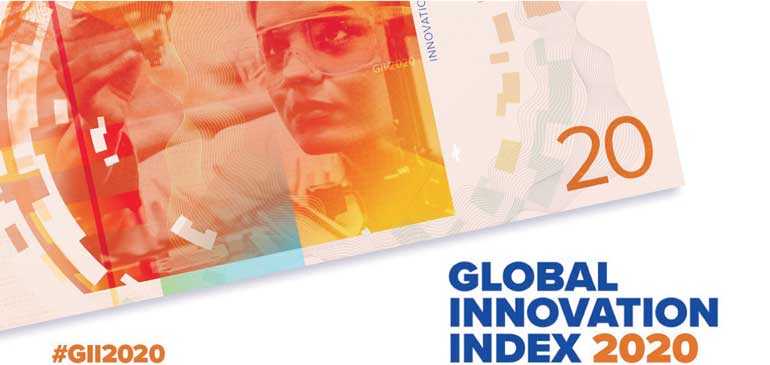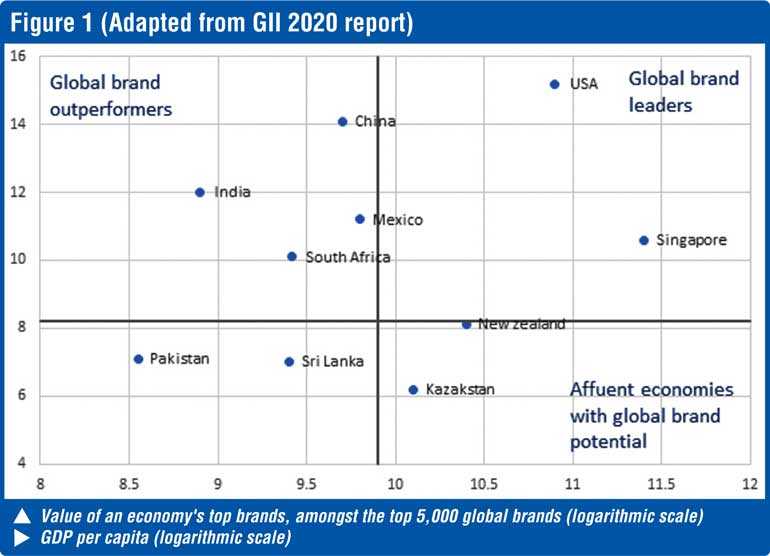Thursday Mar 06, 2025
Thursday Mar 06, 2025
Friday, 11 September 2020 00:00 - - {{hitsCtrl.values.hits}}


Ruchi Gunewardene and Shemara Stephens of Brand Finance Lanka reviews Sri Lanka’s global standing on innovation and analyse the role of brands
In September 2020, the 13th annual edition of the Global Innovation Index (GII) was released by World Intellectual Property Organization (WIPO) presenting the latest global innovation trends, ranking 131 countries
The publication determines the metrics and methods that capture the richness of innovation in nations across the world. With many governments putting innovation at the centre of their growth strategies to drive economic progress and competitiveness, especially in the context of post-COVID recovery, this report is an invaluable source of information.
The definition of innovation as set out here has broadened—it is no longer restricted to R&D laboratories and published scientific papers. According to WIPO, innovation could be and is more general and horizontal in nature, including social, business model, and technical innovation.
The methodology used for the latest report includes capturing a total of 80 indicators which are grouped under seven pillars: institutions, human capital and research, infrastructure, market sophistication, business sophistication, knowledge and technology outputs, and creative outputs.
Sri Lanka’s performance is not particularly encouraging being placed towards the bottom end of the index, ranked at 101 out of a total of 131 nations that were benchmarked.
Role of brands in innovation
According to the report, on average, firms that invest more in innovation invest more on brands as this is an important way to secure returns on their R&D investments. To move up the global value chains and to increase the possibility of capturing greater profit margins, companies in low-and middle-income economies increasingly seek to develop their own brands or to acquire them from abroad.
As a result, global branding investments approached half a trillion dollars and account for a growing share of GDP— equivalent to about one-third of global research and development (R&D).
In this context, for the first time, GII included brand value as one of its indicators. The results of Brand Finance’s public study of the 5,000 most valuable and strongest brands in the world have been used to create this. The values of the most valuable brands in each economy are added and scaled by GDP to rank the countries.
Sri Lanka’s brand value performance on the index
Sri Lanka finds itself higher up the index in the brand value indicator, being ranked at 55.
When the level of development of a country is plotted against its share of brand value in the top global brands Sri Lanka falls in the lower left quadrant, see Figure 1. What this means is that Sri Lanka belonging to the middle- and low-income economies group, has brands that make it into the top 5,000 ranking, but their value is relatively low.
Countries like USA and Singapore in the top right quadrant are global brand leaders because of their high brand value. India with a lower GDP than Sri Lanka has a higher proportion of valuable brands, ranked at 31, making them a global brand outperformer. China, Mexico and South Africa are similarly clustered as outperformers. Whilst Sri Lanka scores higher to Kazakhstan on this index, its not too far behind New Zealand, which is a smaller country but with a much higher income.
This would suggest that Sri Lanka has significant potential for expansion and growth of local brands, which can help improve the brand value ranking on this index.
Brand and innovation in Sri Lankan exports
In order to make headway in the area of brands, with a relatively small economy, Sri Lanka has no option but to look outward to expand through a more global reach.
The importance of brands in global marketing goes beyond consumer goods such as Dilmah, which is relatively well known on the world stage. For businesses which sell products or services to other businesses (B2B), brands play a significant role. Sri Lanka’s billion dollar companies MAS and Brandix are two great examples. It is no coincidence that both these companies are heavily reliant on innovation to drive their global businesses, without which they would not have succeeded in this highly competitive market.
There is significant innovation happening across multiple industries in Sri Lanka which can benefit from stronger brands. These include the IT sector, specialised products for global manufactures and even innovative ventures taking new technologies to developing countries in the African continent, by many enterprising Sri Lankan companies.
What this means for Sri Lankan companies
The inclusion of brand value in GII demonstrates international recognition of the importance of brands for value creation, especially in supporting economic recovery, and the growing consensus around the need for reliable and independent intangible asset valuations.
The point is, that whilst companies build innovation capabilities, the brand should not be neglected. Building brands require consistency and investment over the long term. For B2B brands this is not only about investing in trade fairs to acquire new customers but building a brand from within, through employee engagement and actively establishing points of relevant differentiation with customers.
Sri Lankan companies need to use brands for global reach and customer impact, thereby harnessing even more value through their world class innovations.
Discover Kapruka, the leading online shopping platform in Sri Lanka, where you can conveniently send Gifts and Flowers to your loved ones for any event including Valentine ’s Day. Explore a wide range of popular Shopping Categories on Kapruka, including Toys, Groceries, Electronics, Birthday Cakes, Fruits, Chocolates, Flower Bouquets, Clothing, Watches, Lingerie, Gift Sets and Jewellery. Also if you’re interested in selling with Kapruka, Partner Central by Kapruka is the best solution to start with. Moreover, through Kapruka Global Shop, you can also enjoy the convenience of purchasing products from renowned platforms like Amazon and eBay and have them delivered to Sri Lanka.
Discover Kapruka, the leading online shopping platform in Sri Lanka, where you can conveniently send Gifts and Flowers to your loved ones for any event including Valentine ’s Day. Explore a wide range of popular Shopping Categories on Kapruka, including Toys, Groceries, Electronics, Birthday Cakes, Fruits, Chocolates, Flower Bouquets, Clothing, Watches, Lingerie, Gift Sets and Jewellery. Also if you’re interested in selling with Kapruka, Partner Central by Kapruka is the best solution to start with. Moreover, through Kapruka Global Shop, you can also enjoy the convenience of purchasing products from renowned platforms like Amazon and eBay and have them delivered to Sri Lanka.